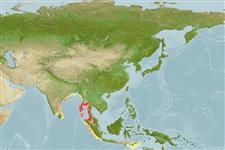>
Acanthuriformes (Surgeonfishes) >
Lobotidae (Tripletails)
Etymology: Hapalogenys: Greek, hapalos = soft * Greek, geny, -yos = face (Ref. 45335); merguiensis: Named for its type locality, Mergui Basin, southern Myanmar Sea..
Environment: milieu / climate zone / depth range / distribution range
Ecología
marino; rango de profundidad 78 - 180 m (Ref. 36944). Tropical
Eastern Indian Ocean: known only from the Andaman Sea, off southern Myanmar, including Mergui Basin and Taninthayi Coast, and off Phuket, west coast of Thailand. Possibly occurring in the Andaman and Nicobar islands, Bay of Bengal and Straits of Malacca.
Tamaño / Peso / Age
Maturity: Lm ? range ? - ? cm
Max length : 17.9 cm SL macho / no sexado; (Ref. 36944); 24.2 cm SL (female)
Short description
Morfología | Morfometría
Espinas dorsales (total): 6; Radios blandos dorsales (total): 14; Espinas anales 3; Radios blandos anales: 9 - 10; Vértebra: 24. Head and body generally dark brownish when fresh. Two indistinct oblique dark bands on body, the first descending from the nape to behind the pectoral fin; the second from base of anterior 2nd or 3rd dorsal fin spines and soft dorsal fin base, curving backward thru the lateral line to soft anal fin and caudal peduncle. Maxillary scales absent. Eye diameter greater than one quarter of the head length. Ten pores on and behind the chin; often with slitlike pores posteriorly. Fleshy lower lip with a cluster of very short dense papillae. At the origin of the dorsal fin is a procumbent spinelike process (exposed tip of first pterygiophore) (Ref. 36944).
Occurs over rocky bottom.
Life cycle and mating behavior
Madurez | Reproducción | Puesta | Huevos | Fecundidad | Larva
Iwatsuki, Y., U. Satapoomin and K. Amaoka, 2000. New species: Hapalogenys merguiensis (Teleostei; Perciformes) from Andaman Sea. Copeia 2000(1):129-139. (Ref. 36944)
IUCN Red List Status (Ref. 130435)
Human uses
Más información
Nombres comunesSinónimosMetabolismoDespredadoresEcotoxicologíaReproducciónMadurezPuestaAgregación para la puestaFecundidadHuevosEgg development
Age/SizeCrecimientoLength-weightLength-lengthLength-frequenciesMorfometríaMorfologíaLarvaDinámica larvariaReclutamientoAbundanciaBRUVS
ReferenciasAcuiculturaPerfil de acuiculturaRazasGenéticaElectrophoresesheritabilidadEnfermedadesProcesamientoNutrientsMass conversion
ColaboradoresImágenesStamps, Coins Misc.SonidosCiguateraVelocidadTipo de nataciónSuperficie branquialOtolitosCerebrosVisión
Herramientas
Special reports
Download XML
Fuentes de Internet
Estimates based on models
Preferred temperature (Ref.
123201): 17.6 - 23.2, mean 21.7 °C (based on 14 cells).
Phylogenetic diversity index (Ref.
82804): PD
50 = 0.5078 [Uniqueness, from 0.5 = low to 2.0 = high].
Bayesian length-weight: a=0.01862 (0.00830 - 0.04177), b=3.01 (2.81 - 3.21), in cm total length, based on LWR estimates for this (Sub)family-body shape (Ref.
93245).
Nivel trófico (Ref.
69278): 3.9 ±0.6 se; based on size and trophs of closest relatives
Resiliencia (Ref.
120179): Alto, población duplicada en un tiempo mínimo inferior a 15 meses (Preliminary K or Fecundity.).
Fishing Vulnerability (Ref.
59153): Low vulnerability (20 of 100).
